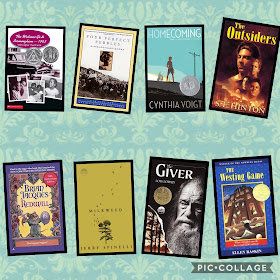This week for NCTE Reads, we are delving into the development of pedagogy that addresses young adult literature in the classroom. Element 1 focuses on classroom community.
Many years ago, I learned that it is pointless to discuss rules and procedures on the first day of school. Students are tired and adjusting to being back on a schedule. They are excited to see their friends and what teachers they have but not to learn anything, especially on day one. So I switched gears and started focusing on classroom community from the first day of school. If we are going to be a family for 178 days, we need to be comfortable with one another. I have no issues with building community within the first two days of schools. But how to I extend this community into teaching young adult literature?
_______________________________________________
Which quality do I try to focus on?
Quality #1: Belief that the work is important
Buehler discusses that teachers must treat young adult literature in the same capacity as they do classic literature. My classroom library consists of mostly young adult literature and a few pieces from the canon. Although I do not teach young adult literature in my AVID class, the selections for middle school English in my district are mostly young adult titles. Books I have taught in my fourteen years of teaching include:
In regard to classic literature, I did teach Treasure Island one time (and it was one time for a reason), and I taught Tom Sawyer one time. I would rather not discuss how those went over.
I have to say that I think I have treated these works seriously. Except for that one time when I made fun of A Wrinkle in Time profusely for everyone being saved by love (not my favorite story). Ok, I also expressed a few negative thoughts about the end of The Giver. But aside from that, I swear I have treated these books with the utmost respect.
I do read everything I can from my own classroom library, and I have done my best to make sure I have books that represent all of my students, and some of those titles have to be treated with care (ex. Fat Angie, Aristotle and Dante Discover the Secrets of the World, Tomboy). When I have one-on-one conversations with students about the books they choose, I always treat the chosen story as the greatest novel ever written.
_______________________________________________
 I would have to say that the rest of the qualities are all challenges for me in the AVID classroom, as the class itself is not a literature class. The previous coordinator did tell me that there have been years when the classes examine a shared text, but not in the traditional sense of what we teach in English language arts. They have read We Beat the Streets to share and discuss how they can overcome the odds against them.
I would have to say that the rest of the qualities are all challenges for me in the AVID classroom, as the class itself is not a literature class. The previous coordinator did tell me that there have been years when the classes examine a shared text, but not in the traditional sense of what we teach in English language arts. They have read We Beat the Streets to share and discuss how they can overcome the odds against them. I suppose this text could meet the Quality #4: Collective investment in a shared experience. I have read the book myself, and it certainly invites discussion and debate. I do not think, however, that this book represents enough of my students for them all to discover deep meaning. Quality #3: A sense of being known and valued focuses on choice as "an element of YA pedagogy" (84). In order to address both of these qualities, I believe I would have to introduce more titles into my classroom, whether fiction or nonfiction, about teens overcoming odds.
In teaching English, I feel confident I could address all four of these qualities and have probably touched on them all at some point in time. Bringing this pedagogy into the AVID classroom is not impossible, but it will take some work on my part. My overall goal is always to show my students that they have value that is important and recognized, so if I have to work a little bit harder for them, so be it.



No comments:
Post a Comment